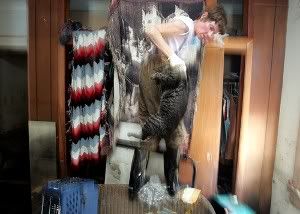The next morning, Magoo was out and about. Later in the day as I was coming back inside, Magoo pushed throught the screen door and out onto the porch. Then, underneath the house and up and down the driveway - we me in hot pursuit. After I caught him, it was dinner time. Magoo shocked me by jumping up on the counter to get a headstart on dinner - which he has never done. Usually, I am chasing him around the house trying to get him to eat. So this is a good sign. Will try the lower .03 dosage (he has lost weight too..) and go every other night and see what happens!
UPDATE - August 22, 2013 Miracle Man Magoo is still hanging tough. He has been able to eat more and the tumor isn't much different. Magoo is out and about and still very much enjoys life!
He is still on the Conium 200c twice daily - the vet also wanted to add the Thuja back as well. He gets one small syringe feeding at night but it's more to get various vitamins into him. Also added food grade hydrogen peroxide to the mix. His multi-daily mouth wash contains calendula, astragalus, and artemisa annua. And with the unavailability of any cannabis oil, I purchased the Dixie Botanicals Dew Drops - a hemp oil with CBD's - it seems to help with anxiety and appetite a lot.
So, keeping fingers crossed that something eventually will shrink or get rid of this tumor and disease - I am so very happy at this point that he is hanging so tough - he's such a good boy!
UPDATE - August 3rd, 2013
A day after I sent out a glowing update on Magoo's progress, I pried open his mouth and found a raggedy growth underneath one side of his tongue. Freaked out - called both traditional and holistic vets. Just assumed that it was tumor regrowth already. I must add that I had given him a night off from the LDN. After I told my holistic vet that Magoo had resumed eating his beloved Indigo Moon kibble, she suggested that the dry food was irritating the surgery site. So I pulled most of it up, much to the other cat's dismay. At the same time, I upped his astragalus mix along with a co-q10 mixed with "Heart Terrain" a mix of supplments and herbs. I also started him on Wormwood - Artemisia Absinthiam but later read that it is the Artemisa Annua Extract (Sweet Annie) that is what is needed
Someone wrote me about Cannabis Oil - I am looking into that - something I have meant to look into for awhile anyway, but there seems to be a lot of info on it being great for most disorders - and cancers! cureyourowncancer.org/
If anyone knows more about this and can help, please contact me!
Meanwhile, Magoo's "tumor site" looks better, smaller and less raggedy
UPDATE - July 26, 2013 -
Magoo got his histopath report back on Tuesday - of course it is SCC - with "intermediate to high-grade features" and "neoplastic cells extend to the margins." The glimmer of hope is that "There is no evidence of any angiolymphatic invasion" - which means it has not spread to the lymph nodes.
The vet who did the surgery didn't even want to do a follow up - no checking of Magoo's mouth - no talk of chemo or other treatment. I was a bit peeved - you'd think that a vet who did a biopsy and put 8 stitches in your cat's tongue might want to see if the poor creature was ok. But never mind - the guy served his purpose - we now have a definitive diagnosis - and I wasn't going to subject Goo to that stuff anyway.
So, after a break from the LDN for a few days due to being on opioids, I started him on 0.32 of the liquid LDN the other night. He is now back on Arnica 50M for pain care but he is eating a little better now - I gave him some "junk food" Friskies and Whiskas canned just to whet his appetite - and he is scoffing that down. And of course, rejecting his grain free stuff - but I am happy that he is eating right now.
The main goal is to try to keep this thing from growing back! The stats don't support this happening - but then again, the stats have never included LDN. I am just hoping that even though the cancer extends past the surgical margins, the surgery might have retarded the growth enough, so that now, the LDN can do it's stuff - well that's the plan anyway. My holistic vet (who actually cares about Magoo) wants me to give him the Thuja 50m as a dilution instead of just dumping the pellets down his throat, for one week. And I guess by then, we will see how he is doing and how his mouth looks. The few peeks that I took didn't show anything really scary - no infection or pus - haven't wanted to push it with him though.
Will update again soon - Dr. Zagon research on Head and Neck Squamous Cell
Head and neck cancers (including oral cavity, pharynx, and larynx) account for 3% of new cases and 2% of cancer deaths annually in the United States,1 and 3% of all new cases worldwide.2,3 More than 90% of all head and neck cancers are of squamous cell origin (SCCHN) Low dosages of the opioid antagonist naltrexone are known to inhibit tumor (ie, human and murine neuroblastoma) growth,33,34 with the effects of opioid antagonists being stereospecific and dependent on the duration of opioid receptor blockade.35,36 In the case of low-dose naltrexone, production of OGF and OGFr is stimulated when the compound is present37,38 and, during the interval when naltrexone is no longer available and does not block opioid receptors, an enhanced interaction between OGF and OGFr ensues, resulting in reductions in cell proliferation. The present results confirm and extend the extensive literature documenting that daily administration of OGF, as well as low-dose naltrexone, can impede the appearance and growth of many tumor types. These previous studies were conducted so that OGF or low-dose naltrexone treatment began at the time of tumor cell inoculation, a model with parallels to the clinical situation wherein the cancers have been extirpated and tumor burden is diminished. However, the present investigation initiated OGF or low-dose naltrexone treatment at the time of established cancer (ie, the appearance of a tumor) and demonstrates that modulation of tumor progression by either agent can also be effective even at later stages of tumorigenesis. Moreover, in contrast with earlier reports using OGF and low-dose naltrexone in a daily regimen, we have discovered that administration of either agent administered just once a week has powerful antitumor activity.
UPDATE - July 17, 2013 -
Magoo had the mass under his tongue cut out yesterday - the vet said that he got "most" of it - anymore and he would have destroyed the tongue. It is most probably SCC but will get back Path report in about a week.Poor Magoo has many stitches under his tongue - he was very restless yesterday and upset that he could not eat his beloved kibble - the canned food juices were easier on him. Hopefully, his tongue will heal soon and he will be back to his normal chow cat ways.
As he was given opioids, I did not resume the LDN dosage - and will wait and see how he is doing later. He was sent home with buprenorphine that I was supposed to start today - however, I might try the arnica 200c instead.
From reading about oral SCC, it seems that whenever these tumors are cut out of the mouth, unless clear margins are achieved, then they do grow back. Well, we shall see - I believe that yesterday's procedure has bought Magoo some time - time for Mom to try to help keep this from coming back. Will keep you updated - meanwhile, please help me help him - if you can spare anything - please use the DONATE button on the sidebar. Some very kind folks have donated Petco gift cards (next biggest expense is cat food!) but unfortunately, Mom can't eat cat food...
UPDATE - July 15, 2013 - Magoo - Tumor in mouth - possible SCC -
A few weeks ago, a mass was found underneath Magoo's tongue - he is going in for biopsy tomorrow. It appears to be oral squamous cell carcinoma but there is a chance that it is some kind of eosinophylic problem instead. Please help Magoo - he will need follow up care after the surgery - and prayers that he does not have cancer. Scroll over to the DONATE button for the "Magoo Cancer Fund" if you can help. Also, this handsome guy has his own CafePress design here: Mr. MagooMagoo CafePress
PANDA RAINBOW BRIDGE - OCTOBER 5, 2010
Panda crossed over at 12:45 AM this morning - up until this past weekend, she had done pretty well. However, the Medicam, while buying her a couple more weeks of life, in the end, affected her liver and kidneys and she began to struggle on Saturday.
I had my own doctor's appointment yesterday but had made arrangements to bring Panda in to be put down that evening. But when I got home from the doctor, she was close to being in a coma. I got her onto the bed where she stretched out on her side - I supported her head with a pillow and also placed one near her paws. Soon, she was kneading the pillows with her paws and breathing deeply, though with her customary purr. I decided to let nature take it's course as she was not suffering.
I awoke at 12:44 to find Panda taking her final breaths - I pet her and kissed her and told her goodbye. That it was okay to go and that I would see her again someday - at the Rainbow Bridge.
Just this side of heaven is a place called Rainbow Bridge.
When an animal dies that has been especially close to someone here, that pet goes to Rainbow Bridge.
There are meadows and hills for all of our special friends so they can run and play together.
There is plenty of food, water and sunshine, and our friends are warm and comfortable.
All the animals who had been ill and old are restored to health and vigor; those who were hurt or maimed are made whole and strong again, just as we remember them in our dreams of days and times gone by.
The animals are happy and content, except for one small thing; they each miss someone very special to them, who had to be left behind.
They all run and play together, but the day comes when one suddenly stops and looks into the distance. His bright eyes are intent; His eager body quivers. Suddenly he begins to run from the group, flying over the green grass, his legs carrying him faster and faster.
You have been spotted, and when you and your special friend finally meet, you cling together in joyous reunion, never to be parted again. The happy kisses rain upon your face; your hands again caress the beloved head, and you look once more into the trusting eyes of your pet, so long gone from your life but never absent from your heart.
Then you cross Rainbow Bridge together....
Author unknown...
Goodbye my love, my heart - you have left the biggest pawprint on my heart and I will never forget you my friend. I love you.
UPDATE - SEPT. 25.
After the last diagnosis of end-stage heart disease, Panda worsened and continued to try and hide. She was struggling to breathe and panting. When I picked her up and put her on the bed, she plopped over onto her side. I called the vet's office again and told them that I was bringing her in to be put down - she was suffering. We got to the vet's office where Panda hobbled around the exam room and seemed to be breathing more normally. Dr. Sagrera watched her and then examined the back of Panda's head - Panda flinched when the area behind her ears was pressed on. Dr. Sagrera said that it was probably due to a tumor in her brain, which was causing her immense pain, which led to her walking about with her head close to the ground. The vet said to try the Medicam, which is a pain killer and analgesic and to see what would happen.
I got Panda home and gave her a small dose of the Medicam - I had some left over from her ear surgery. A couple of hours later, Panda was panting again and trying to push her head under the pillows on the bed. I gave her more Medicam and she eventually went to sleep, breathing easier. Later, after going to bed, I kept reaching over to touch Panda on the bed, to see if she was still breathing. At around 4 AM, I reached over and she was not there - she was at the end of the bed and purring! I got her down and brought her to her litter box, which she used, and took her back to her bed. She demanded breakfast, which I happily gave to her. The rest of the day was uneventful, with Panda dozing for most of it and looking much happier.
That was on the 15th and 16th, and blessedly, Panda has been the same since then! It seems that as long as I can get the right dose of Medicam into her, she is doing okay. And by okay, I mean, getting up and down from the bed on her own, finding her way to the litterbox and water dish. Not bad for a blind cat with a brain tumor and enlarged heart. And not having any more panting or hiding her head episodes. Which is amazing to me that the amount of pain that she must have been in, had led to her symptoms. Whatever the reason, I am blessed that Panda is still with me and happy to be here.
After a hellish night, Panda seemed brighter at 6 a.m. and actually ate some food so I went back to sleep. Upon waking, I couldn't find her and after a 15 minute search, found her wedged in on the side of the fridge. I got her out and she seemed to be having problems walking - she did not want any more food or did not to use her litter box. I called the vet who told me to let her sniff the Vick's vapor rub, which nullifies a homeopathic remedy. I did and left her back on her bed. I had to go out for a bit and when I came back, Panda wasn't on her bed but was in the closet. I got her out and put her on the floor. She seemed to stagger and opened her mouth, panting in a way I had never seen before. So I frantically called the vet back and told the girl who answered the phone that it seemed like it was "time".
I rushed Panda out there where the vet immediately saw her. Panda, meanwhile, had perked up on the way over - she cried most of the trip over - as did I. At Natural Pet Care, the vet has non-traditional exam rooms - just regular rooms with furniture - not the typical little cubicle with the stainless steel table. Panda got up and wandered around the room, getting around much better than she had at home. The vet listened to her chest and suggested a chest x-ray - I was able to check my email on my cell phone and saw that Steve E. had generously made a donation on the blog, so I told the vet to go ahead and do the test. Shortly, the film was ready, and it showed a very enlarged heart - we had known that she had heart problems, but her heart was pushing on her lungs and diaphragm, making it difficult for Panda to breathe. And fortunately, there was no sign of any cancer, at least on the x-ray.
So, for now, we know what we are dealing with! I took Panda back home, where she immediately used her litter box, drank a little water and ate some food - things that she hadn't done in the last two days. She just had a small dinner of wet food and is napping now. The vet also wants me to try and get Taurine and coQ-10 into her as well as the B vitamins and Omega that she is already getting.
Just goes to show you how strong homeopathy can be - those little pellets can pack a wallop! The vet thinks that by tomorrow, any lingering effects of the remedy will be gone. I hope that Panda will perk up even more so that she can enjoy what time she has left with the best quality of life. Thank you Steve E. and to everyone who has donated toward's Panda's veterinary care!
UPDATE - SEPT. 13
Panda has taken a turn for the worse. Last week, she began to get blocked again so she was taken to the vet. The vet felt that Panda's colon was thickened and she also had an ugly ulcer in her mouth - no wonder she seemed so uncomfortable. She has also been waking from her sleep and howling for food, which she would inhale once I'd give it to her. I asked Dr. Sagrera if she thought that the cancer had possibly spread and she said that it was a good possibility - and would explain all of the things that have happened to Panda over the last year. Her original squamous cell carcinoma diagnosis had come a few months following her saga during Hurricane Katrina, which resulted in the loss of her ear.
The vet gave her a homeopathic remedy (Silica 10M) and for the next few days, Panda seemed to spend much of the time sleeping. She ate and used her litterbox regularly. However, starting yesterday and today, she no longer wants to eat and is having problems getting around - not walking, but she will get to her litter box and then just crouch in it and stay in it for hours. She does not seem to be in any pain but is in a fugue like state - she knows me and will purr if I pick her up and talk to her.
I can only hope that this is some kind of "healing crisis" that she will soon pull out of. The vet did say that the Silica can aggravate a problem, or problems, for as long as a week. Today is Monday and she was given the remedy last Thursday.
But I think that she is dying - she is hydrated and looks okay, but so lethargic and out of it that I just don't see how she will pull out of this. I will have to wait until tomorrow to contact my vet as her office is closed on Mondays - but I will call her emergency page number later on tonight it need be - I hope not. I still haven't figured out how to cover the post-dated check that I wrote on Thursday...
I took Panda off of the LDN last week - with the mouth ulcer and her symptoms, it did not seem that it was right to keep giving it to her. She has had almost 5 years since her ear surgery - 4 good years though this last year has been fairly good, even though she lost her sight last October - she has not been in any pain until the impaction problems began and has been able to get around amazingly well.
She is currently on the bed for now, though she will get up every now and then and wander around - but she will run into something and then just sit there - so I am watching her constantly.
I hope that she pulls out of this but I wouldn't be surprised if she just went to sleep on the bed and just never wakes up. If this is her time, then I hope that this is what will happen - I do not want her to suffer any kind of pain. Thankfully, she doesn't seem to be in any - but if she has problems during the night, I will use my vet's emergency number and bring Panda to her - the hell with not having any money. Panda has been my friend since 1996 - one of the longest relationships in my life. We have been through everything together and I do not know what I will do without her.
I really don't want to bury her outside as I probably will be moving in the next year - and I don't want to leave her - though Brooks is out in the garden - I hated to have to bury him as well, but I could not afford to have him cremated, which is what I want for Panda. Regardless, I am heartbroken and the tears are streaming as I type this post.
Please donate if you can. Thank you
UPDATE - JULY 20
Panda is doing great - the extra fatty acids (omega fish oils) have helped her a great deal and she has not had any problems with impaction or constipation - knock on wood. I want to thank everyone who donated towards her veterinary care (and bill)!
But Mom is not doing too well - thankfully, the LDN along with a strict diet and supplements, have restored my health to the point that I can now function. I pray that it stays that way. However, I am struggling to survive here every day and I fear that the unrelenting stress will eventually take a toll.
Though the online book selling and sporadic cat sitting do bring in some income, it is just barely enough to pay the major bills (my credit cards went bye-bye months ago) - utilities, internet, cell phone. The rest goes towards caring for the cats.
I am very small and do not require much food - I have been surviving on potatoes and baked vegetables - with an occassional bit of chicken thrown in. I also still have my fruit smoothie most days though I have been out of the whey protein powder.
If anyone could possibly donate a bit towards the cat care, then I could eat a little more than I have - I've lost 5 pounds in the last couple of weeks and 108 is much too low - I do better around 115 for my 5'4" frame.
Thanks again to all who helped the cats - and thereby helped me!
I haven't been posting too much on the blog lately as I have been struggling to survive here in New Orleans. The cost of living has never gone back to the pre-Katrina days and it's become a lot harder to get by. I just about have my rent money covered and I have paid my utility and car insurance bill. Now, I just have to pay my internet bill - no net, no amazon.com business as a book seller and no blog about LDN and Hep C - and now cats.
My concern is for my cats - the cats are probably the reason that I am here today - they helped bring me back to my childhood roots and my love for all animals - and away from the dark side of the streets.
It was a stray cat that led to my diagnosis of Hepatitis C back in 2002. I took in a stray cat "Oscar" early that year who had a multitude of health problems, including ringworm - and of course, I contracted it. It never would go completely away and I ended up at a doctor, who suggested blood work to "rule anything out". The "anything out" turned out to be Hepatitis C.
Oscar lost his life in early 2004 due to his health problems - but I will never forget him or be able to thank him enough. True, I would have been diagnosed eventually with the HCV, but finding out in 2002 might have saved my liver from additional stress.

Panda needs help - she is my oldest cat at around 15 - no one really knows how old she truly is. She was seen today at the vet and will require many vet visits to keep her comfortable for whatever time she has left. She is a cancer survivor who lost an ear to the disease - she recently went blind and, understandably, does not get around too much - hence, she becomes frequently becomes impacted and needs to see the vet for care.
I first met Panda in early 1996 when I moved into a new apartment following my separation. She was part of a large colony of cats that the former tenant had been feeding (and not spaying and neutering).

Unbeknownst to me, Panda had been adopted as a feral kitten, spayed and vaccinated by the tenant and then left behind when she moved. I kept wondering why Panda kept trying to get inside.
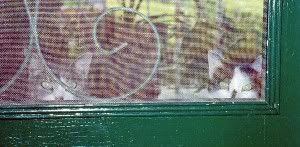
I ended up trapping all of the cats and having them spayed or neutered. In 1998, my landlord decided to sell the house and I was forced to move to another apartment about a mile away. I took Panda and Emerald with me.
Panda kept getting scared and disappearing - she kept going back to her old house, which now had a new owner who did not like cats. For a cat, a mile is not that far away, but she had to cross a major thoroughfare and railroad tracks to do so. I probably went back 5 different times to get her, until one day, she was not there. I went back for almost a month to look for her but never could find her and I feared the worst. However, one day, I got a call from the new owner - there was a black and white cat hanging around the house - could I come look at her. It was Panda! Skinny and scared but ok. I took her back and finally started bringing her inside and she never left again.
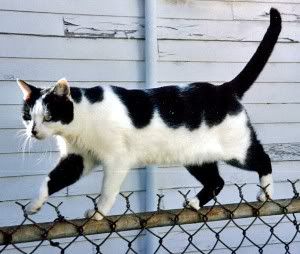
During those early years at the new apartment, I had a boyfriend, who had a Min Pin. She had a litter of pups that Panda enjoyed teasing and toying with.
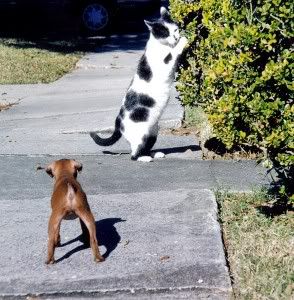
As the years went on, my boyfriend moved away and I returned to cat rescue - and had a house full of cats, as well as caring for the multiple feral cats in the neighborhood. In 2002, I was devastated to learn that I had contracted Hepatitis C, and put me on a health roller coaster for the next several years. (I have detailed this story on my blog, Nola Hepper.
In August of 2005, I found myself with a broke down car, little money and 8 inside cats, along with many feral cats outside. Hurricane Katrina hit New Orleans and the cats and I were trapped inside my apartment with flood waters up to my neck. Emerald did not come in for the storm and was drowned under the floor boards. I was able to get rescued from my roof with 3 of the cats the next morning - Panda, Cayenne and Rosemary. The 5 others were placed up in high closets out of the water - it took me 2 weeks to get back to the house, via a boat, to rescue them - miraculously, they were all still alive!
I detailed our saga on my first post on this blog, here are a few links:
Photos from August 29th, 2005 Katrina
Photos from the LA Times
L.A. Times Sept. 12, 2005 story
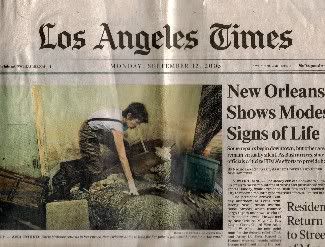
Inside, they had a rather unflattering photo of my getting back up into the closet where the cats were - this was the closet that I was in after the water rose...
We spent 6 months in Alabama after Katrina. Panda had suffered an ordeal and ended up with squamous cell carcinoma, which led to surgery to remove her ear. The animal group IMOM (In Memory of Magic) and Best Friends both contributed towards Panda's surgery.
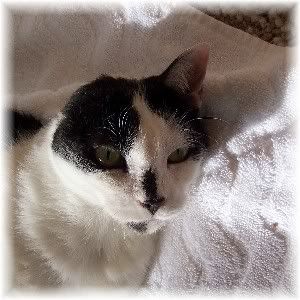
I moved back to New Orleans to a new apartment in early 2006 and became involved with the ongoing cat rescue. My old Lakeview neighborhood had been devastated and most of the feral cats had been killed - either drowned or killed by the ensuing dog packs that roamed the area for many months following Katrina. There were only 3 cats out of the 40 or so in my area that survived. I was able to do this for almost two years until my health took a turn for the worse. I developed shingles, severe IBD and fibromyalgia and at times, could barely get out of bed.
Fortunately, my Social Security appeal ruled in my favor and I soon was on Medicare and receiving a small disability check of $693.00 monthly. The Medicare enabled me to find a good integrative doctor, whose treatment helped me greatly - she also pointed me towards Dr. Berkson, who put me on the Low Dose Naltrexone (LDN). His protocol alone helped restore my liver health to almost normal.
Meanwhile, I lost Brooks, one of the Katrina survivors who had been left in the high closets, due to renal failure. His illness was costly and wiped out the remainder of my savings - though most of the money had gone towards my medical treatment and supplements that were not covered by Medicare.
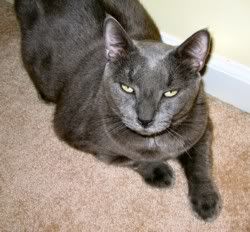
Right before Brooks passed, Panda suddenly lost her sight! It was first thought that she had an infection but she did not respond to treatment. She was then taken to an eye specialist who thought that her cancer had returned and was causing her blindness. However, her blood work was normal and that diagnosis was later ruled out.
She managed go get around fairly well in the ensuing months, but lately has had a problem with impacted anal glands - which actually abscessed a couple of months back. I took her to the vet a few weeks ago to have them expelled and still owe my vet for that visit. Panda is having problems again and is close to another abscess. Today, my wonderful vet agreed to see Panda again, even though I cannot pay for the visit. I promised the vet's office that I would try and raise the money for payment.
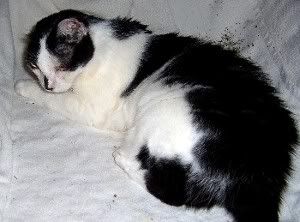
If you can help pay for Panda's vet visit or donate towards the care of the other cats, please go to the "Donate" button which leads to our PayPal account. The DONATE button is on the right menu.
The Others
Cayenne came along in January 1999 - a neighbor found him and put a milk crate over him and called the SPCA. He was still there the next day, so I took him to the vet - and, of course, ended up keeping him.
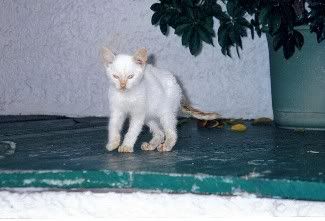
After Katrina, with Sky:
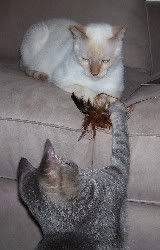
Rosemary was found in the back alley with her brothers and sisters in 2001:

Now:
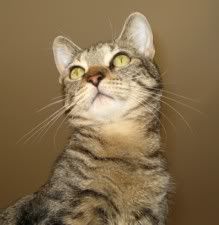
Woody was a relative of Rosemary's - found in the same alley - and very, very sick as a baby:
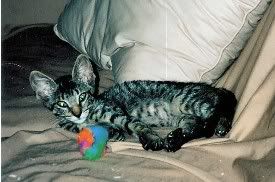
She came close to liver failure following her ordeal after Katrina and flirted with it again last summer.
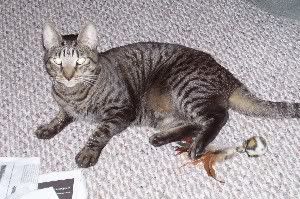
Tortie Miss was an older feral kitten who was trapped across the street from us - she started following Cayenne home and ended up as an inside cat - lucky for her as all of her outside buddies perished after Katrina.
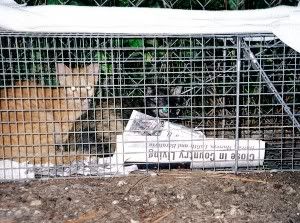
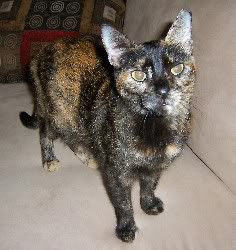
Mr. Magoo (Goober) showed up in 2002 with Oscar and never left:
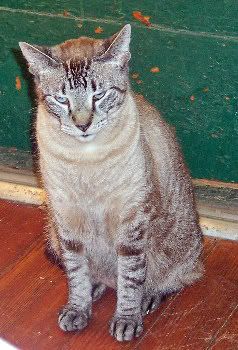
Sky and her littermates appeared in the alley in 2004 - they were all trapped, tamed and adopted through PetsSmart. However, Sky got sick and was returned to me - by the time that she healed, she was too old for adoption:
sky kitten trap


After I moved back here in 2006 and was doing cat rescue, I trapped 4 kittens from my old neighborhood - the abandoned house where they were born was being demolished so I could not release them after they were spayed/neutered. The two tamest kittens were taken to ARNO, who later shipped them out of state where they were both adopted. I kept the other two - Velvet and Smoke.
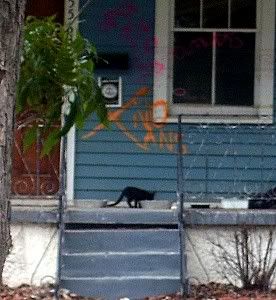

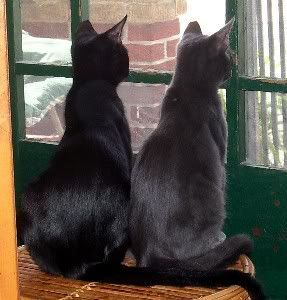
Please help me continue to care for my cats as I have managed to do for many, many years. They saved my life and I am responsible for caring for them to the best of my ability - even with Hepatitis C, Celiac Disease and the multiple other viruses and conditions that I have.
If you are able to contribute to the cat's care, please go to the menu on the right - and either go to the Widget or to the DONATE button. Or, you can help by purchasing a book from Amazon via my account at:
CMBOOKMAKER
If you are in the New Orleans area, I offer a Cat Sitting or Cat Consultant service at:
Nola Catbox
Thank you so much for your help!


